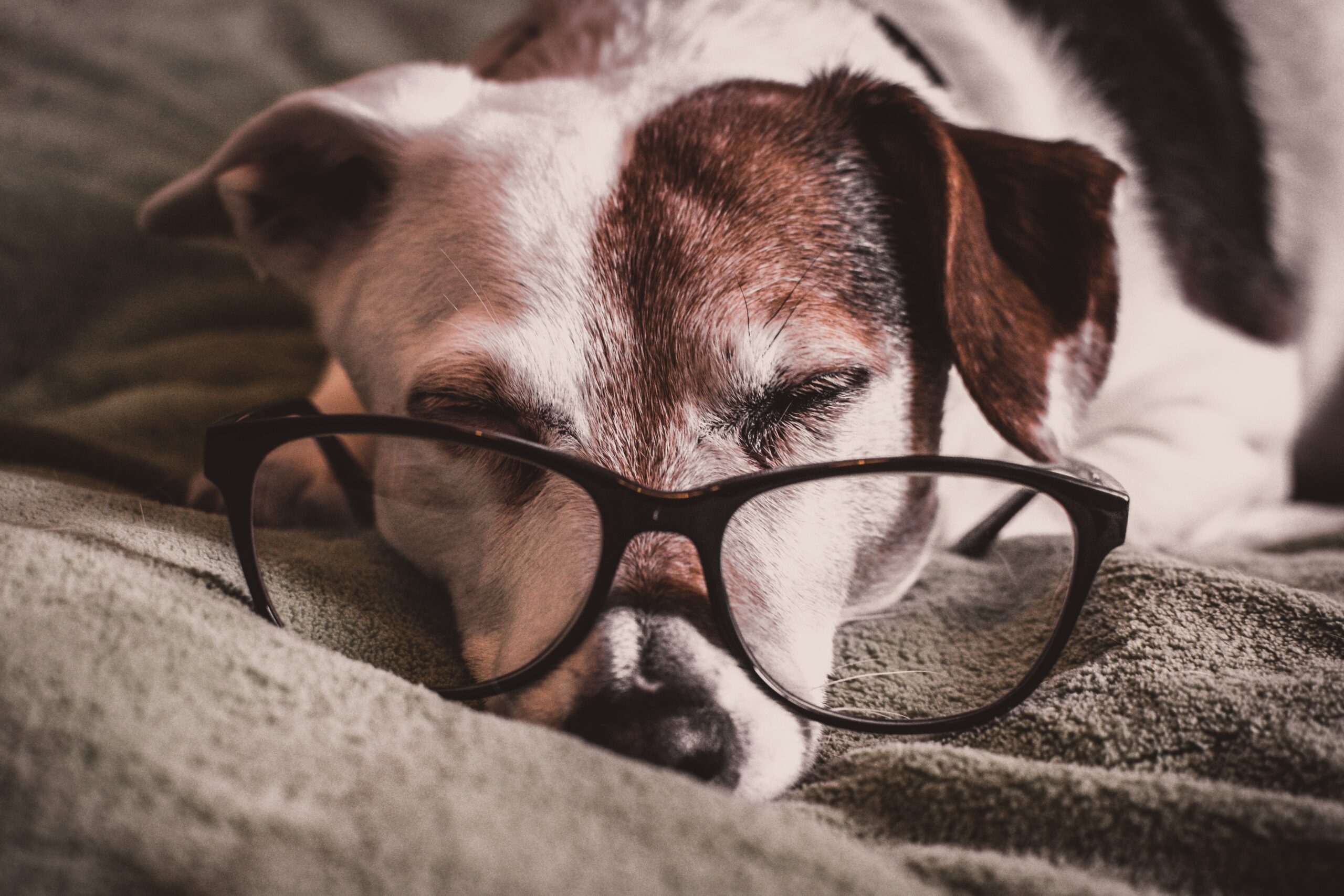Recent Posts
- The Benefits of Adopting a Rescue Dog: Giving a Second Chance at Life
- The Ultimate Guide to Managing Dog Allergies
- The Science of Canine Sleep: Understanding Your Dog’s Sleep Patterns and Needs
- “In the Doghouse”: The History, Usage, and Canine Care Tips for Dog Lovers
- Protecting Your Pet: Waterborne Hazards for Dogs in Lakes, Rivers, and Oceans
Categories

The Science of Canine Sleep: Understanding Your Dog’s Sleep Patterns and Needs
Just like humans, dogs need sleep to maintain their overall health and wellbeing. However, canine sleep patterns differ from ours, and understanding these patterns can help you ensure your dog gets the rest they need. In this article, we’ll delve into the science of canine sleep, exploring the various life stages of dogs and how their sleep needs change throughout their lives. We’ll also provide helpful tips for creating an optimal sleep environment for your furry friend.
Sleep Patterns in Dogs
Dogs experience two main types of sleep: slow-wave sleep (SWS) and rapid eye movement (REM) sleep. During SWS, dogs rest their bodies and brains, while REM sleep is when they dream. Adult dogs generally spend 12-14 hours a day sleeping, with approximately 10% of that time in REM sleep.

Puppyhood
Puppies need more sleep than adult dogs, often sleeping up to 18-20 hours per day. Sleep is vital for their growth and development, as well as helping them process new experiences and information. During this stage of their lives, puppies are rapidly growing, both physically and mentally, so their bodies require more rest to support this rapid development.
In addition to supporting growth, sleep helps puppies consolidate their learning and memories. As puppies encounter new experiences and are exposed to various stimuli, they need sufficient sleep to process and store this information. Ensuring your puppy gets enough sleep can help them develop better social skills, cognitive abilities, and adaptability.
To promote healthy sleep patterns in puppies, consider the following tips:
- Establish a consistent sleep schedule: Encourage your puppy to sleep at regular intervals by setting up a routine, including bedtime and wake-up time.
- Create a designated sleep area: Provide a comfortable, quiet space specifically for your puppy to sleep. This can be a crate, a dog bed, or a designated room.
- Minimize distractions: Keep noise levels low and reduce exposure to stimulating activities right before bedtime.
- Encourage daytime activity: Engage your puppy in age-appropriate play and exercise during the day to help them expend energy and sleep better at night.
Adulthood
As dogs mature into adulthood, their sleep patterns become more established. They may spend more time awake during the day and sleep through the night, with occasional naps. A healthy diet and regular exercise, such as using K9 Sprinter’s mobile gyms, can help maintain their energy levels and support healthy sleep patterns.
Adult dogs still require a significant amount of sleep, usually between 12-14 hours per day, depending on their breed, size, and activity levels. It’s essential to recognize your dog’s individual sleep needs and ensure they have ample opportunity to rest.
To promote healthy sleep patterns in adult dogs, consider the following tips:
- Maintain a consistent routine: Regular mealtimes, exercise, and sleep schedules can help your dog maintain a stable sleep pattern.
- Offer mental stimulation: Engaging in mentally challenging activities during the day, such as puzzle toys or training sessions, can help tire out your dog’s brain and improve their sleep quality.
- Monitor their diet: A balanced and nutritious diet is crucial for maintaining your dog’s energy levels and overall health. Be mindful of their food intake and make adjustments if necessary.
- Address any underlying health issues: Regular checkups with your veterinarian can help identify and treat any health problems that may be affecting your dog’s sleep.
Senior Dogs
Senior dogs often require more sleep, particularly if they suffer from health issues like obesity or joint pain. It’s essential to provide proper care for senior dogs to ensure they remain comfortable and well-rested as they age. As dogs get older, they may experience a decline in cognitive function, mobility, and overall energy levels, making quality sleep even more critical.
To promote healthy sleep patterns in senior dogs, consider the following tips:
- Adapt their environment: Older dogs may have difficulty getting comfortable due to joint pain or other age-related issues. Provide orthopedic beds, ramps, or steps to help them access their sleeping area more easily.
- Adjust their exercise routine: Senior dogs still need regular physical activity, but the intensity and duration may need to be modified. Tailor their exercise routine to accommodate their changing abilities.
- Monitor their diet: As your dog ages, their dietary needs may change. Consult with your veterinarian to determine the appropriate diet for your senior dog to maintain a healthy weight and support joint health.
- Prioritize regular vet checkups: Early detection and treatment of age-related health issues can help improve your senior dog’s quality of life and sleep. Schedule regular veterinary visits to monitor their health and address any concerns promptly.
- Provide mental stimulation: Cognitive decline is common in older dogs, so it’s essential to keep their minds sharp with appropriate mental exercises. Interactive toys, puzzles, and gentle training sessions can help maintain cognitive function and promote better sleep.
- Be patient and understanding: Senior dogs may have more difficulty settling down to sleep or may wake up more frequently during the night. Be patient with your aging pet and provide comfort and reassurance when needed.
In summary, understanding and addressing the unique sleep needs of your dog at each stage of their life—puppyhood, adulthood, and senior years—is vital for their overall health and well-being. By creating an optimal sleep environment, establishing a consistent routine, and addressing any health issues or concerns, you can help your dog get the restorative sleep they need to thrive.
Remember that every dog is different, and their sleep needs may vary depending on their breed, size, and individual characteristics. Always consult with your veterinarian or a professional, and learn how like the experts at K9 Sprinter, can help you pup. Together, we can ensure your furry companion enjoys a happy, healthy, and well-rested life.

Decoding Canine Sleep Patterns: Essential Information for Pet Owners
As pet owners, it’s crucial to understand our dogs’ sleep patterns to ensure their overall health and well-being. A well-rested dog is happier, more energetic, and less prone to health issues. In this section, we will delve deeper into the fascinating world of canine sleep, exploring factors that influence sleep patterns, the importance of exercise, and how services like K9 Sprinter can help your dog achieve better sleep. By gaining insights into your dog’s sleep habits, you can support their restorative rest and pave the way for a happy, healthy life.
- Sleep cycles: Like humans, dogs experience different stages of sleep, including light sleep, deep sleep, and rapid eye movement (REM) sleep. During REM sleep, dogs may dream and exhibit twitching, vocalizations, or even sleep running. These behaviors are normal and generally not a cause for concern.
- Sleep positions: Dogs may sleep in various positions, such as curled up, sprawled out, or on their backs. Each position can convey information about a dog’s comfort, security, and temperature regulation needs. For example, a dog sleeping curled up may be trying to conserve body heat, while a dog sleeping on its back may be attempting to cool off.
- Sleep disruptions: Occasional disruptions in sleep patterns can occur due to changes in routine, environment, or stress. However, persistent sleep disturbances could signal an underlying health issue or anxiety. In such cases, it’s essential to consult with a veterinarian or professional dog trainer to address the problem.
- Napping habits: Dogs, especially puppies and senior dogs, may nap frequently throughout the day. These short rest periods can help dogs recharge and maintain their energy levels. Allowing your dog to nap as needed can support their overall health and well-being.
- Sleeping with owners: Some dogs prefer to sleep with their owners, while others are content sleeping in their designated beds or crates. It’s essential to establish a routine and sleeping arrangement that works best for both you and your dog. Consistency is key in helping your dog maintain healthy sleep patterns.
Factors Affecting Canine Sleep: In-depth Analysis: Factors Impacting Canine Sleep Patterns
Several factors can impact a dog’s sleep patterns, including:
Health Issues
Illnesses, pain, or infections like parvovirus can cause disruptions in a dog’s sleep patterns. Pain can make it difficult for your dog to find a comfortable position to sleep, while illnesses can cause fatigue or restlessness. Regular checkups with your veterinarian can help identify and treat any health problems that may be affecting your dog’s sleep.
Environment
A dog’s sleep environment should be comfortable and free from distractions. Factors such as temperature, noise, and lighting can all impact a dog’s ability to sleep. Ensure their sleeping area is quiet, dark, and at a comfortable temperature. Providing a cozy bed or blanket can also help create a welcoming sleep environment.
Diet
A nutritious diet can promote healthy sleep patterns by providing your dog with the essential nutrients they need for energy and overall health. The right diet can also help manage your dog’s weight, reducing the risk of sleep-disrupting health issues. Read more about your dogs diet and what is the best way to feed them by reading our blog.
The Importance of Regular Exercise for Canine Sleep and the Benefits of K9 Sprinter Services
How Regular Exercise Helps Dogs Sleep
Regular exercise plays a crucial role in promoting healthy sleep patterns for dogs. An active dog is more likely to experience deeper and more restful sleep, as physical activity helps tire their bodies and minds, making it easier for them to fall asleep and stay asleep. Here’s how regular exercise helps dogs sleep:
- Energy expenditure: Exercise allows dogs to burn off excess energy, which can help prevent restlessness and anxiety during sleep.
- Mental stimulation: Physical activity often involves problem-solving, coordination, and focus, providing mental stimulation that can tire a dog’s brain and lead to better sleep.
- Stress reduction: Exercise releases endorphins, which help improve mood and reduce stress. Lower stress levels can contribute to a more relaxed state and better sleep.
- Weight management: Regular exercise helps maintain a healthy weight, reducing the risk of obesity and associated health issues that can disrupt sleep, such as sleep apnea or joint pain.
- Regulation of sleep-wake cycles: Exercise can help regulate a dog’s circadian rhythm, promoting more consistent sleep-wake cycles.
How K9 Sprinter Services and Slat Mills Can Improve Your Dog’s Sleep
K9 Sprinter offers a range of services designed to keep your dog physically active and mentally stimulated, ultimately contributing to better sleep quality. One of the innovative exercise tools used by K9 Sprinter is the slat mill, which is specifically designed for canine fitness. Here’s how K9 Sprinter services and slat mills can help improve your dog’s sleep:
Tailored Exercise Programs
K9 Sprinter creates customized exercise programs based on your dog’s breed, age, fitness level, and health needs. These personalized plans ensure your dog gets the appropriate amount and type of exercise for optimal sleep benefits. Tailored programs also account for any pre-existing conditions or limitations, making sure your dog can exercise safely and effectively. By addressing your dog’s unique needs, K9 Sprinter helps build healthy exercise habits that contribute to better sleep quality and overall well-being.
Convenient Mobile Gyms
K9 Sprinter’s mobile gyms bring exercise opportunities directly to your doorstep, making it easy to maintain a consistent exercise routine for your dog. These state-of-the-art gyms are equipped with specialized equipment and resources to provide a safe and controlled environment for canine fitness. By eliminating the need for travel, mobile gyms offer a convenient solution for busy pet owners, ensuring that their dogs can stay active and reap the sleep benefits of regular exercise.
Professional Guidance
The expert team at K9 Sprinter can provide guidance on the most effective exercise techniques and strategies for promoting healthy sleep in your dog. With their extensive knowledge and experience, they can help you understand the link between exercise and sleep, teach you how to recognize signs of fatigue or sleep disturbances, and offer solutions to address sleep-related issues. By working closely with K9 Sprinter professionals, you can gain valuable insights and support in helping your dog achieve better sleep through exercise.
Slat Mill Advantages
Slat mills offer a controlled environment for canine exercise, allowing dogs to run at their own pace without distractions. This focused exercise can help tire out your dog, both mentally and physically, leading to better sleep. The consistent, smooth movement of the slat mill also helps develop your dog’s stamina, strength, and cardiovascular fitness, all of which can contribute to improved sleep quality. Additionally, slat mills can be adjusted to cater to your dog’s specific exercise needs, ensuring a challenging yet safe workout tailored to their individual requirements.
Low-Impact Exercise
Slat mills provide a low-impact workout, reducing stress on your dog’s joints and minimizing the risk of injury. This is particularly beneficial for older dogs or those with joint issues that can impact sleep quality. The design of slat mills allows for even weight distribution and natural movement, lessening the impact on joints and promoting a more comfortable exercise experience. As a result, dogs that may struggle with traditional forms of exercise due to age or health concerns can still enjoy the sleep benefits of regular physical activity without causing further discomfort or harm.
Creating an Optimal Sleep Environment
To help your dog get a good night’s rest, consider the following tips:
- Provide a comfortable bed or sleeping area.
- Keep the sleep area quiet and dark, reducing disturbances from noise or light.
- Establish a consistent sleep schedule and routine for your dog.
- Address any underlying health issues that may be affecting your dog’s sleep.
We can provide guidance on your dog’s specific needs, answer any frequently asked questions, and offer tailored solutions to improve your dog’s sleep quality.
Understanding your dog’s sleep patterns and needs is crucial for their overall health and wellbeing. By taking the time to learn about the different life stages and how they pertain to canine sleep, you can better support your furry companion throughout their life. Don’t hesitate to reach out to professionals like those at K9 Sprinter for assistance in ensuring your dog gets the rest they need to lead a happy, healthy life.
Remember, a well-rested dog is not only more energetic and alert but also better able to fight off illness, maintain a healthy weight, and enjoy a higher quality of life. So, pay attention to your dog’s sleep patterns and needs, and let sleeping dogs lie.
For more information on K9 Sprinter’s services, visit their pricing and booking page and explore the various options available to help your dog achieve optimal health and happiness.

The Science of Canine Sleep: Understanding Your Dog’s Sleep Patterns and Needs
Just like humans, dogs need sleep to maintain their overall health and wellbeing. However, canine sleep patterns differ from ours, and understanding these patterns can help you ensure your dog gets the rest they need. In this article, we’ll delve into the science of canine sleep, exploring the various life stages of dogs and how their sleep needs change throughout their lives. We’ll also provide helpful tips for creating an optimal sleep environment for your furry friend.
Sleep Patterns in Dogs
Dogs experience two main types of sleep: slow-wave sleep (SWS) and rapid eye movement (REM) sleep. During SWS, dogs rest their bodies and brains, while REM sleep is when they dream. Adult dogs generally spend 12-14 hours a day sleeping, with approximately 10% of that time in REM sleep.

Puppyhood
Puppies need more sleep than adult dogs, often sleeping up to 18-20 hours per day. Sleep is vital for their growth and development, as well as helping them process new experiences and information. During this stage of their lives, puppies are rapidly growing, both physically and mentally, so their bodies require more rest to support this rapid development.
In addition to supporting growth, sleep helps puppies consolidate their learning and memories. As puppies encounter new experiences and are exposed to various stimuli, they need sufficient sleep to process and store this information. Ensuring your puppy gets enough sleep can help them develop better social skills, cognitive abilities, and adaptability.
To promote healthy sleep patterns in puppies, consider the following tips:
- Establish a consistent sleep schedule: Encourage your puppy to sleep at regular intervals by setting up a routine, including bedtime and wake-up time.
- Create a designated sleep area: Provide a comfortable, quiet space specifically for your puppy to sleep. This can be a crate, a dog bed, or a designated room.
- Minimize distractions: Keep noise levels low and reduce exposure to stimulating activities right before bedtime.
- Encourage daytime activity: Engage your puppy in age-appropriate play and exercise during the day to help them expend energy and sleep better at night.
Adulthood
As dogs mature into adulthood, their sleep patterns become more established. They may spend more time awake during the day and sleep through the night, with occasional naps. A healthy diet and regular exercise, such as using K9 Sprinter’s mobile gyms, can help maintain their energy levels and support healthy sleep patterns.
Adult dogs still require a significant amount of sleep, usually between 12-14 hours per day, depending on their breed, size, and activity levels. It’s essential to recognize your dog’s individual sleep needs and ensure they have ample opportunity to rest.
To promote healthy sleep patterns in adult dogs, consider the following tips:
- Maintain a consistent routine: Regular mealtimes, exercise, and sleep schedules can help your dog maintain a stable sleep pattern.
- Offer mental stimulation: Engaging in mentally challenging activities during the day, such as puzzle toys or training sessions, can help tire out your dog’s brain and improve their sleep quality.
- Monitor their diet: A balanced and nutritious diet is crucial for maintaining your dog’s energy levels and overall health. Be mindful of their food intake and make adjustments if necessary.
- Address any underlying health issues: Regular checkups with your veterinarian can help identify and treat any health problems that may be affecting your dog’s sleep.
Senior Dogs
Senior dogs often require more sleep, particularly if they suffer from health issues like obesity or joint pain. It’s essential to provide proper care for senior dogs to ensure they remain comfortable and well-rested as they age. As dogs get older, they may experience a decline in cognitive function, mobility, and overall energy levels, making quality sleep even more critical.
To promote healthy sleep patterns in senior dogs, consider the following tips:
- Adapt their environment: Older dogs may have difficulty getting comfortable due to joint pain or other age-related issues. Provide orthopedic beds, ramps, or steps to help them access their sleeping area more easily.
- Adjust their exercise routine: Senior dogs still need regular physical activity, but the intensity and duration may need to be modified. Tailor their exercise routine to accommodate their changing abilities.
- Monitor their diet: As your dog ages, their dietary needs may change. Consult with your veterinarian to determine the appropriate diet for your senior dog to maintain a healthy weight and support joint health.
- Prioritize regular vet checkups: Early detection and treatment of age-related health issues can help improve your senior dog’s quality of life and sleep. Schedule regular veterinary visits to monitor their health and address any concerns promptly.
- Provide mental stimulation: Cognitive decline is common in older dogs, so it’s essential to keep their minds sharp with appropriate mental exercises. Interactive toys, puzzles, and gentle training sessions can help maintain cognitive function and promote better sleep.
- Be patient and understanding: Senior dogs may have more difficulty settling down to sleep or may wake up more frequently during the night. Be patient with your aging pet and provide comfort and reassurance when needed.
In summary, understanding and addressing the unique sleep needs of your dog at each stage of their life—puppyhood, adulthood, and senior years—is vital for their overall health and well-being. By creating an optimal sleep environment, establishing a consistent routine, and addressing any health issues or concerns, you can help your dog get the restorative sleep they need to thrive.
Remember that every dog is different, and their sleep needs may vary depending on their breed, size, and individual characteristics. Always consult with your veterinarian or a professional, and learn how like the experts at K9 Sprinter, can help you pup. Together, we can ensure your furry companion enjoys a happy, healthy, and well-rested life.

Decoding Canine Sleep Patterns: Essential Information for Pet Owners
As pet owners, it’s crucial to understand our dogs’ sleep patterns to ensure their overall health and well-being. A well-rested dog is happier, more energetic, and less prone to health issues. In this section, we will delve deeper into the fascinating world of canine sleep, exploring factors that influence sleep patterns, the importance of exercise, and how services like K9 Sprinter can help your dog achieve better sleep. By gaining insights into your dog’s sleep habits, you can support their restorative rest and pave the way for a happy, healthy life.
- Sleep cycles: Like humans, dogs experience different stages of sleep, including light sleep, deep sleep, and rapid eye movement (REM) sleep. During REM sleep, dogs may dream and exhibit twitching, vocalizations, or even sleep running. These behaviors are normal and generally not a cause for concern.
- Sleep positions: Dogs may sleep in various positions, such as curled up, sprawled out, or on their backs. Each position can convey information about a dog’s comfort, security, and temperature regulation needs. For example, a dog sleeping curled up may be trying to conserve body heat, while a dog sleeping on its back may be attempting to cool off.
- Sleep disruptions: Occasional disruptions in sleep patterns can occur due to changes in routine, environment, or stress. However, persistent sleep disturbances could signal an underlying health issue or anxiety. In such cases, it’s essential to consult with a veterinarian or professional dog trainer to address the problem.
- Napping habits: Dogs, especially puppies and senior dogs, may nap frequently throughout the day. These short rest periods can help dogs recharge and maintain their energy levels. Allowing your dog to nap as needed can support their overall health and well-being.
- Sleeping with owners: Some dogs prefer to sleep with their owners, while others are content sleeping in their designated beds or crates. It’s essential to establish a routine and sleeping arrangement that works best for both you and your dog. Consistency is key in helping your dog maintain healthy sleep patterns.
Factors Affecting Canine Sleep: In-depth Analysis: Factors Impacting Canine Sleep Patterns
Several factors can impact a dog’s sleep patterns, including:
Health Issues
Illnesses, pain, or infections like parvovirus can cause disruptions in a dog’s sleep patterns. Pain can make it difficult for your dog to find a comfortable position to sleep, while illnesses can cause fatigue or restlessness. Regular checkups with your veterinarian can help identify and treat any health problems that may be affecting your dog’s sleep.
Environment
A dog’s sleep environment should be comfortable and free from distractions. Factors such as temperature, noise, and lighting can all impact a dog’s ability to sleep. Ensure their sleeping area is quiet, dark, and at a comfortable temperature. Providing a cozy bed or blanket can also help create a welcoming sleep environment.
Diet
A nutritious diet can promote healthy sleep patterns by providing your dog with the essential nutrients they need for energy and overall health. The right diet can also help manage your dog’s weight, reducing the risk of sleep-disrupting health issues. Read more about your dogs diet and what is the best way to feed them by reading our blog.
The Importance of Regular Exercise for Canine Sleep and the Benefits of K9 Sprinter Services
How Regular Exercise Helps Dogs Sleep
Regular exercise plays a crucial role in promoting healthy sleep patterns for dogs. An active dog is more likely to experience deeper and more restful sleep, as physical activity helps tire their bodies and minds, making it easier for them to fall asleep and stay asleep. Here’s how regular exercise helps dogs sleep:
- Energy expenditure: Exercise allows dogs to burn off excess energy, which can help prevent restlessness and anxiety during sleep.
- Mental stimulation: Physical activity often involves problem-solving, coordination, and focus, providing mental stimulation that can tire a dog’s brain and lead to better sleep.
- Stress reduction: Exercise releases endorphins, which help improve mood and reduce stress. Lower stress levels can contribute to a more relaxed state and better sleep.
- Weight management: Regular exercise helps maintain a healthy weight, reducing the risk of obesity and associated health issues that can disrupt sleep, such as sleep apnea or joint pain.
- Regulation of sleep-wake cycles: Exercise can help regulate a dog’s circadian rhythm, promoting more consistent sleep-wake cycles.
How K9 Sprinter Services and Slat Mills Can Improve Your Dog’s Sleep
K9 Sprinter offers a range of services designed to keep your dog physically active and mentally stimulated, ultimately contributing to better sleep quality. One of the innovative exercise tools used by K9 Sprinter is the slat mill, which is specifically designed for canine fitness. Here’s how K9 Sprinter services and slat mills can help improve your dog’s sleep:
Tailored Exercise Programs
K9 Sprinter creates customized exercise programs based on your dog’s breed, age, fitness level, and health needs. These personalized plans ensure your dog gets the appropriate amount and type of exercise for optimal sleep benefits. Tailored programs also account for any pre-existing conditions or limitations, making sure your dog can exercise safely and effectively. By addressing your dog’s unique needs, K9 Sprinter helps build healthy exercise habits that contribute to better sleep quality and overall well-being.
Convenient Mobile Gyms
K9 Sprinter’s mobile gyms bring exercise opportunities directly to your doorstep, making it easy to maintain a consistent exercise routine for your dog. These state-of-the-art gyms are equipped with specialized equipment and resources to provide a safe and controlled environment for canine fitness. By eliminating the need for travel, mobile gyms offer a convenient solution for busy pet owners, ensuring that their dogs can stay active and reap the sleep benefits of regular exercise.
Professional Guidance
The expert team at K9 Sprinter can provide guidance on the most effective exercise techniques and strategies for promoting healthy sleep in your dog. With their extensive knowledge and experience, they can help you understand the link between exercise and sleep, teach you how to recognize signs of fatigue or sleep disturbances, and offer solutions to address sleep-related issues. By working closely with K9 Sprinter professionals, you can gain valuable insights and support in helping your dog achieve better sleep through exercise.
Slat Mill Advantages
Slat mills offer a controlled environment for canine exercise, allowing dogs to run at their own pace without distractions. This focused exercise can help tire out your dog, both mentally and physically, leading to better sleep. The consistent, smooth movement of the slat mill also helps develop your dog’s stamina, strength, and cardiovascular fitness, all of which can contribute to improved sleep quality. Additionally, slat mills can be adjusted to cater to your dog’s specific exercise needs, ensuring a challenging yet safe workout tailored to their individual requirements.
Low-Impact Exercise
Slat mills provide a low-impact workout, reducing stress on your dog’s joints and minimizing the risk of injury. This is particularly beneficial for older dogs or those with joint issues that can impact sleep quality. The design of slat mills allows for even weight distribution and natural movement, lessening the impact on joints and promoting a more comfortable exercise experience. As a result, dogs that may struggle with traditional forms of exercise due to age or health concerns can still enjoy the sleep benefits of regular physical activity without causing further discomfort or harm.
Creating an Optimal Sleep Environment
To help your dog get a good night’s rest, consider the following tips:
- Provide a comfortable bed or sleeping area.
- Keep the sleep area quiet and dark, reducing disturbances from noise or light.
- Establish a consistent sleep schedule and routine for your dog.
- Address any underlying health issues that may be affecting your dog’s sleep.
We can provide guidance on your dog’s specific needs, answer any frequently asked questions, and offer tailored solutions to improve your dog’s sleep quality.
Understanding your dog’s sleep patterns and needs is crucial for their overall health and wellbeing. By taking the time to learn about the different life stages and how they pertain to canine sleep, you can better support your furry companion throughout their life. Don’t hesitate to reach out to professionals like those at K9 Sprinter for assistance in ensuring your dog gets the rest they need to lead a happy, healthy life.
Remember, a well-rested dog is not only more energetic and alert but also better able to fight off illness, maintain a healthy weight, and enjoy a higher quality of life. So, pay attention to your dog’s sleep patterns and needs, and let sleeping dogs lie.
For more information on K9 Sprinter’s services, visit their pricing and booking page and explore the various options available to help your dog achieve optimal health and happiness.
Recent Posts
- The Benefits of Adopting a Rescue Dog: Giving a Second Chance at Life
- The Ultimate Guide to Managing Dog Allergies
- The Science of Canine Sleep: Understanding Your Dog’s Sleep Patterns and Needs
- “In the Doghouse”: The History, Usage, and Canine Care Tips for Dog Lovers
- Protecting Your Pet: Waterborne Hazards for Dogs in Lakes, Rivers, and Oceans


